#andean goose
Explore tagged Tumblr posts
Text


1 note
·
View note
Text
Alrighty and HERE ARE OUR CONTENDERS!!!
Tag for the polls: #bird battle
DISCLAIMER - I wrote the round one blurbs when I was very sick and half awake, so if you see any mistakes PLEASE TELL ME! Nicely, obviously, but I want to make sure they sound good for round 2. Thank you!
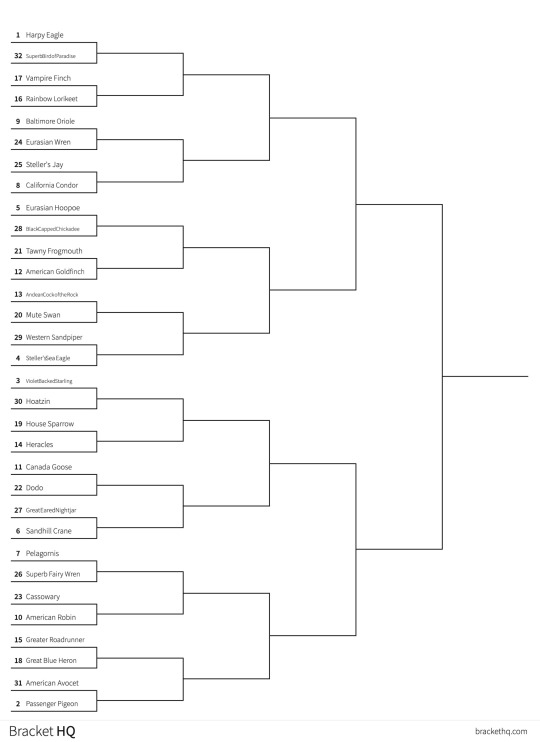

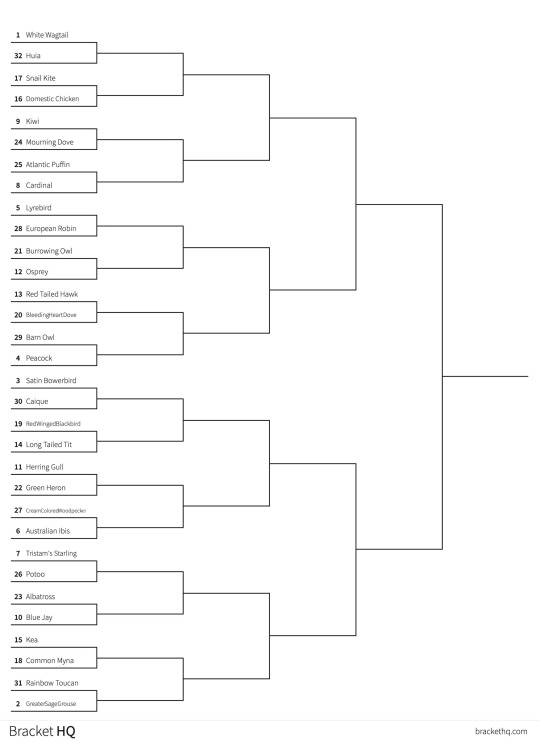

I know there’s a lot of them, but man there’s SO MANY GOOD BIRDS! There were a few times where people didn’t put what specific subspecies for some birds, so sometimes I’d have to choose one. I tried to choose one that represents that bird the best!
I don’t know when the polls will begin, I’m doing some research on the birds so that people can read about them before they vote.
If one of your favs didn’t make it in, don’t worry they’re a winner in my and your heart.
If you are wondering where the Pigeon (Rock Dove) is, THEY ARE THE FINAL CHAMPION! At the end of this bracket, the winner will face off against the mightily popular Rock Dove! Will they be able to beat such a tough challenger? We will see…
Also, a note on how I set this bracket up: I put all the birds in a numbered list and then used a number generator. I think the matchups we got were really interesting.
Full list under the cut
HARPY EAGLE
SUPERB BIRD OF PARADISE
VAMPIRE FINCH
RAINBOW LORIKEET
BALTIMORE ORIOLE
EURASIAN WREN
STELLER'S JAY
CALIFORNIA CONDOR
EURASIAN HOOPOE
BLACK CAPPED CHICKADEE
TAWNY FROGMOUTH
AMERICAN GOLDFINCH
ANDEAN COCK OF THE ROCK
MUTE SWAN
WESTERN SANDPIPER
STELLER'S SEA EAGLE
VIOLET BACKED STARLING
HOATZIN
HOUSE SPARROW
HERACLES
CANADIAN GOOSE
DODO
GREAT EARED NIGHTJAR
SANDHILL CRANE
PELAGORNIS
SUPERB FAIRY WREN
SOUTHERN CASSOWARY
AMERICAN ROBIN
GREATER ROADRUNNER
GREAT BLUE HERON
AMERICAN AVOCET
PASSENGER PIGEON
WALLCREEPER
GREAT TIT
MOA
EASTERN BLUEBIRD
AUSTRALIAN BUSHTURKEY
EMU
MALLARD DUCK
FLAME BOWERBIRD
MANDARIN DUCK
BELTED KINGFISHER
OILBIRD
FAIRY PENGUIN
LESSER FLAMINGO
AUSTRALIAN KESTREL
CARRION CROW
UMBRELLABIRD
LOGGERHEAD SHRIKE
PERUVIAN PELICAN
CALIFORNIA QUAIL
MACGREGORS BOWERBIRD
HARRIS HAWK
COMMON RAVEN
BEARDED VULTURE
PEREGRINE FALCON
ROSY LOVEBIRD
ROSEATTE SPOONBILL
LONG TAILED GRACKLE
AMERICAN WOODCOCK
KAKAPO
BLUE FOOTED BOOBY
RHEA
BEE HUMMINGBIRD
WHITE WAGTAIL
HUIA
SNAIL KITE
DOMESTIC CHICKEN
KIWI
MOURNING DOVE
ATLANTIC PUFFIN
CARDINAL
LYREBIRD
EUROPEAN ROBIN
BURROWING OWL
OSPREY
RED TAILED HAWK
BLEEDING HEART DOVE
BARN OWL
PEACOCK
SATIN BOWERBIRD
CAIQUE
RED WINGED BLACKBIRD
LONG TAILED TIT
HERRING GULL
GREEN HERON
CREAM COLORED WOODPECKER
AUSTRALIAN IBIS
TRISTAM'S STARLING
POTOO
WANDERING ALBATROSS
BLUE JAY
KEA
COMMON MYNA
RAINBOW TOUCAN
GREATER SAGE GROUSE
TURKEY VULTURE
TUFTED TITMOUSE
CRESTED AUKLET
EURASIAN MAGPIE
BUDGIE
SCREECH OWL
WIP-POOR-WILL
SECRETARY BIRD
AUSTRALIAN MAGPIE
CEDAR WAXWING
VICTORIA CROWNED PIGEON
HERMIT THRUSH
COMMON SWIFT
WHITE BELLBIRD
BROWN SKUA
EUROPEAN DIPPER
111 notes
·
View notes
Text
THE FULL FUCKED UP BIRD BRACKET
All birds have been randomized, the seeds mean nothing. Yes pitohui is spelled incorrectly in the bracket image.
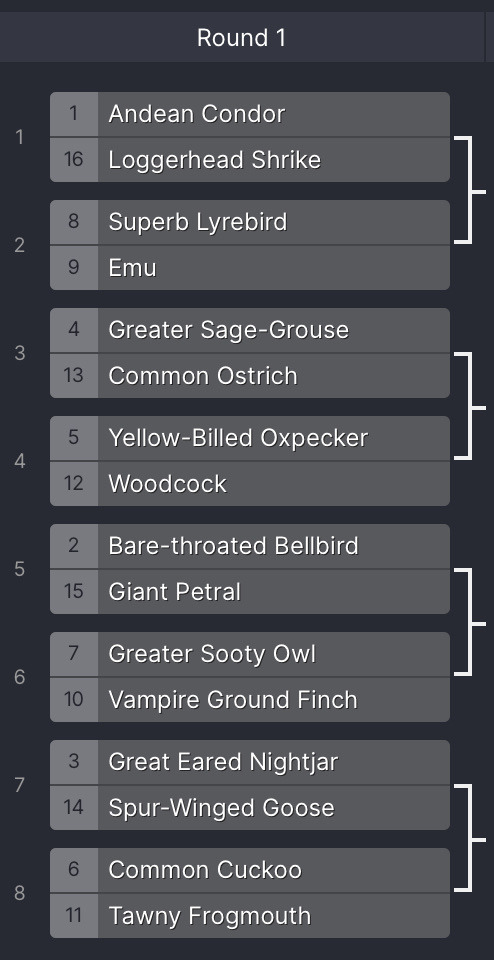
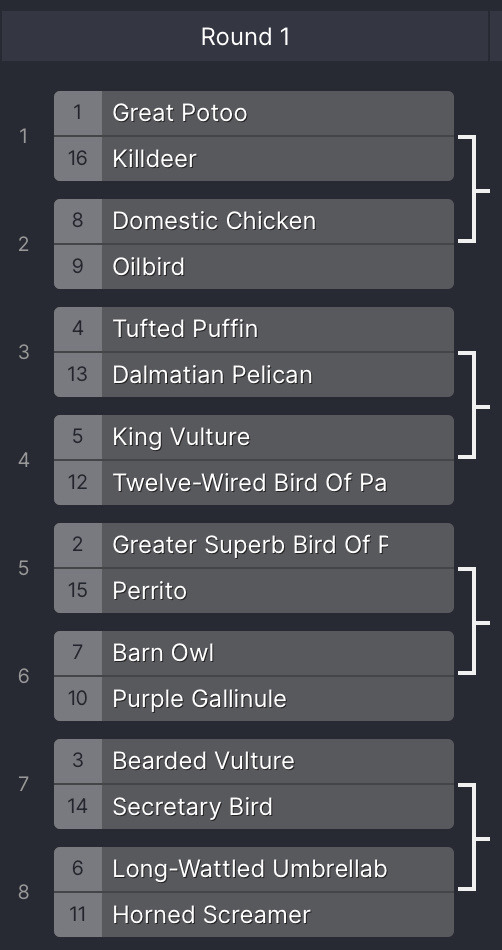

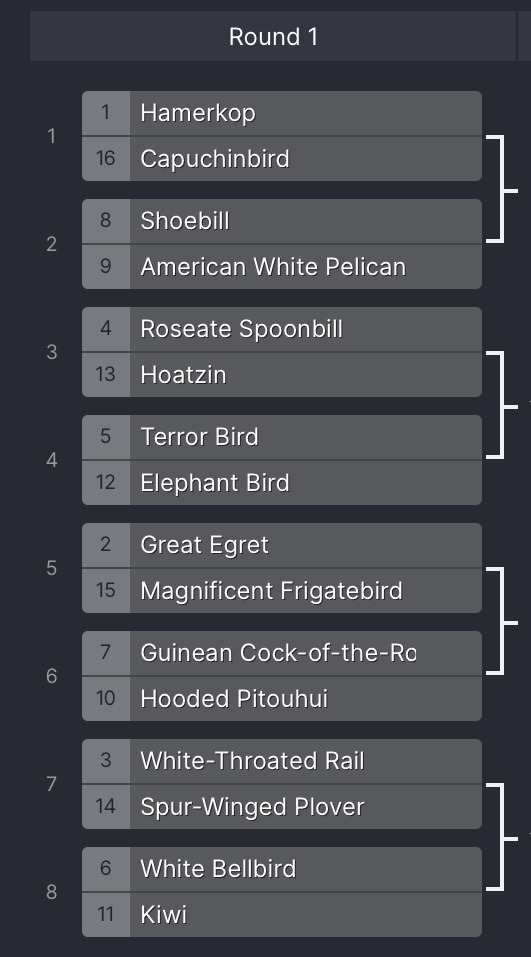
GROUP A
Andean Condor VS Loggerhead Shrike
Superb Lyrebird VS Emu
Greater Sage-Grouse VS Common Ostrich
Yellow-Billed Oxpecker VS American Woodcock
Bare-Throated Bellbird VS Giant Petrel
Greater Sooty Owl VS Vampire Ground Finch
Great Eared Nightjar VS Spur-Winged Goose
Common Cuckoo VS Tawny Frogmouth
GROUP B
Great Potoo VS Killdeer
Domestic Chicken VS Oilbird
Tufted Puffin VS Dalmatian Pelican
King Vulture VS Twelve-Wired Bird Of Paradise
Greater Superb Bird Of Paradise VS Perrito
Barn Owl VS Purple Gallinule
Bearded Vulture VS Secretary Bird
Long Wattled Umbrellabird VS Horned Screamer
GROUP C
Oriental Bay Owl VS Anhinga
Pennant Winged Nightjar VS Snowy Sheathbill
Red-Legged Seriema VS Marabou Stork
Argentavis VS Common Loon
Black Skimmer VS Luzon Bleeding-Heart
Southern Cassowary VS Flamingo (all species)
Green Heron VS Great Hornbill
African Jacana VS California Condor
GROUP D
Hamerkop VS Capuchinbird
Shoebill Stork VS American White Pelican
Roseate Spoonbill VS Hoatzin
Terror Bird VS Elephant Bird
Great Egret VS Magnificent Frigatebird
Guinean Cock-Of-The-Rock VS Hooded Pitohui
White-Throated Rail VS Spur-Winged Plover
White Bellbird VS Kiwi
Polls will be tagged with their BRACKET (example: #bracket a) and #tournament poll
MAY THE WORST BIRD WIN
#information#all of these matchups fucking suck /lovingly#these are literally just all bad bitches being pitted against each other#BRUTAL AS HELLLLLL#mod gf#birdbracket
85 notes
·
View notes
Text
Wildlife Encounters on the Ausangate Trek Peru
The Ausangate Trek Peru is not just about breathtaking landscapes; it's also a paradise for wildlife enthusiasts. As you traverse the high-altitude trails, you'll witness diverse Andean fauna thriving in their natural habitat.
One of the most iconic sightings on the trek is the vicuña, a wild relative of the alpaca, known for its fine wool and graceful movements. These elegant creatures roam freely across the rugged terrain, often seen grazing near glacial streams. The region is also home to the Andean condor, one of the largest flying birds in the world. With its impressive wingspan, spotting a condor soaring above the valleys is a truly mesmerizing experience.
As you hike with Ausangate Peru, you may also encounter herds of llamas and alpacas, integral to the local Quechua communities. Keep an eye out for elusive wildlife like the Andean fox and the vizcacha, a rodent resembling a rabbit, often spotted resting on rocky outcrops. Birdwatchers will be delighted by species such as the giant coot, Puna ibis, and Andean goose.
The Ausangate Trek Peru offers more than just adventure; it immerses you in a thriving ecosystem where nature and culture coexist harmoniously. Whether you're captivated by majestic condors or the gentle presence of alpacas, each step on this trek brings you closer to the wonders of the Andean wilderness.
0 notes
Text
Night Photography!

A "Wolf Moon" Hovers Over the Frigid Sangre De Cristo Mountains at Twilight, San Luis Valley, Colorado.

Glowing tents dot the grass around Les Cheserys Lake in the French Alps.

A grove of Giant Sequoia Trees frame a towering white fir tree under starry skies in Sequoia National Park, California.

An Aurora Borealis Bends across the sky in South East Greenland.

Grotto Geyser Steams under star-filled skies at Midway Geyser Basin in Yellowstone National Park.

Arbol de Piedra (The Stone Tree), is a 20-Foot-Tall Rock Formation in Bolivia’s Eduardo Avaroa Andean Fauna National Reserve.

An Inverted Crescent Moon hanging high over the Kalahari Desert at twilight, South Africa.

Forest elephants graze in the grasslands of central Gabon. While many people often want to go up close when it comes to animal photography, it sometimes helps to take some distance and create images that create a sense of place.

With plenty of practice and patience, kids can capture sweet photographs like this one of a Canada Goose and Her Goslings. Photograph By Melissa Groo Photography

A Marbled Godwit stands in Bowdoin Lake in Montana. Photograph By Melissa Groo Photography
0 notes
Photo

A super sleepy Andean Goose at WWT Slimbridge.
This little cutie (look at that tiny pink beak!) is not in fact a goose, but is more closely related to the Shelduck. They are terrestial grazing geese normally found at high altitudes in the Andes in South America and only take to the water when threatened.
#goose#cute ducks#cute birds#Shelduck#andean goose#wwt slimbridge#wildlife photography#duckdaysout#duckfacts#cute animals
24 notes
·
View notes
Photo



Andenvögel wie der Puna Ibis, das Giant Coot/Riesenblässhuhn und die Andean Goose/Andenganz sammeln sich an solchen Wasserstellen.
1 note
·
View note
Text
I love your Goose 🥰🥰🥰
Suggestions for you:
Mav = black-footed cat
Ice = harp seal
Slider = andean condor
Hollywood = red fox
Wolfman = wolfdog
Sundown = sugar glider
Chipper = hedgehog
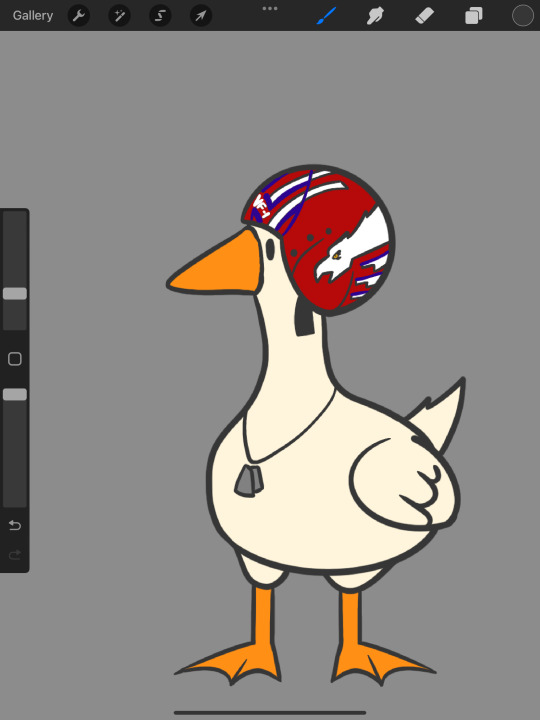
ok but? little goose sticker
i wanna make the whole group into little animals (i can not draw humans)
any suggestions for animals for the others? im thinking (least) weasel for mav tbh
320 notes
·
View notes
Text
Neochen

Andean Geese, by Arpingstone, in the Public Domain
PLEASE SUPPORT US ON PATREON. EACH and EVERY DONATION helps to keep this blog running! Any amount, even ONE DOLLAR is APPRECIATED! IF YOU ENJOY THIS CONTENT, please CONSIDER DONATING!
Name: Neochen
Status: Extant
First Described: 1918
Described By: Oberholser
Classification: Dinosauria, Saurischia, Eusaurischia, Theropoda, Neotheropoda, Averostra, Tetanurae, Orionides, Avetheropoda, Coelurosauria, Tyrannoraptora, Maniraptoriformes, Maniraptora, Pennaraptora, Paraves, Eumaniraptora, Averaptora, Avialae, Euavialae, Avebrevicauda, Pygostylia, Ornithothoraces, Euornithes, Ornithuromorpha, Ornithurae, Neornithes, Neognathae, Galloanserae, Anseriformes, Anseres, Anatoidea, Anatidae, Tadorninae
Species: N. pugil (extinct), N. debilis (extinct), N. barbadiana (extinct), N. jubata (Orinoco Goose, extant), N. melanoptera (Andean Goose, extant)

Andean Geese by Josue Hermoza, CC BY-SA 3.0
Neochen is a small genus of Shelducks that are, mistakenly, named Geese! These birds live entirely in South America, with two living species - the Orinoco Goose and the Andean Goose. Fossil evidence of this bird come from species known from the Middle to Late Pleistocene, so starting from around 1 million years ago, in the Calabrian age, with species obviously still around today. N. debilis is the earliest known species, living in Argentina, and it was quite small compared to living species. N. barbadiana is known from later in the Pleistocene and is known from Brazil and Argentina, and it was rather average in size. Finally, N. pugil lasted until the early Holocene, living in Brazil, and it actually grew to be much larger than the living Orinoco Goose.

Orinoco Goose by BirdPhotos, CC BY 3.0
The Orinoco Goose is a fairly rare bird, considered near threatened with extinction, known from the tropical forests in South America. It has a pale head and neck, with a reddish body and green-black wings, as well as pink legs and a black bill. The sexes are identical in color, with the males being larger; the juveniles, as per usual, are duller in color. They are very terrestrial and even perch in trees, rarely found flying. They are very territorial and nest in hollow trees, rather than on the ground.

Andean Goose by Arpingstone, in the Public Domain
The Andean Goose is slightly better fairing, not considered threatened with extinction. They live primarily in the Andes, usually above 3000 meters, and they are very terrestrial birds. They are heavily built, with white fronts of their bodies and black tails, with pink bills and eggs. They graze on grasses in their high environment, and actually has more efficient hemoglobin for better breathing in the low-oxygen environment they call home. They nest on the ground and are very territorial during the breeding season.
Buy the author a coffee: http://ko-fi.com/kulindadromeus
Sources:
https://en.wikipedia.org/wiki/Neochen
https://en.wikipedia.org/wiki/Neochen_pugil
https://en.wikipedia.org/wiki/Neochen_debilis
https://en.wikipedia.org/wiki/Neochen_barbadiana
https://en.wikipedia.org/wiki/Orinoco_goose
https://en.wikipedia.org/wiki/Andean_goose
#shelduck#dinosaur#bird#neochen#goose#duck#neochen pugil#neochen dibilis#neochen barbadiana#neochen melanoptera#andean goose#neochen jubata#orinoco goose#palaeoblr#birblr#dinosaurs#paleontology#prehistory#prehistoric life#biology#a dinosaur a day#a-dinosaur-a-day#dinosaur of the day#dinosaur-of-the-day#science#nature#factfile#Dìneasar#דינוזאור#डायनासोर
47 notes
·
View notes
Text


0 notes
Note
Hello! I deeply appreciate the work you put into sharing information. If you one day find the time and spoons, would it be possible for you to write a post about the Fuegian/Yaghan dog? Thank you for reading, and thank you for everything you've written.💚
A post about recent extinction of dogs and canid species from Tierra del Fuego and Patagonia?
You mean, like this?

It's a previous post (January 2020) of mine about updates and recent research on the extinct Falkland Islands wolf (Dusicyon australis) and another Patagonian fox (Dusciyon avus) which also went extinct during the Holocene.
The Fuegian dog is thought to have been a domesticated form of the Dusicyon foxes.
Includes info from these recent papers:
Jeremy J. Austin et al. "The origins of the enigmatic Falkland Islands wolf." Nature Communications. 2013.
Luciano Prates. "Crossing the boundary between humans and animals: the extinct fox Dusicyon avus [...]." Antiquity. 2012.
Francisco J. Prevosti et al. "Extinctions in near time: new radiocarbon dates point to a very recent disappearance of the South American fox Dusicyon avus (Carnivora: Canidae)." Biological Journal of the Linnean Society. November 2015.
It has typically been thought that Dusicyon avus was extinct before 1000 BC, but this last paper (Prevosti et al.) proposes that the fox may have persisted in small remnant populations until European invasion.
Meanwhile, the Falkland Islands wolf (also called warrah or the Antarctic wolf), endemic to the Islas Malvinas (Falkland Islands), famously went extinct after colonial invasion. British settlers thought of the wolf as a threat to introduced lambs.
Darwin visited the islands and wrote about the creature around 1833; the "Antarctic wolf" was apparently extinct by 1880.
Speaking of, here's another post about the extinction of the Falkland Islands wolf and the introduction of European agriculture (and Darwin's dismissal of Indigenous people of Patagonia). The paper: James JA Blair. "Settler indigeneity and the eradication of the non-native: self-determination and biosecurity in the Falkland Islands (Malvinas)." Journal of the Royal Anthropological Institute. 2017.


I don't know anything about domesticated Fuegian dogs themselves. (Some of their historical record is gleaned from twentieth-century Euro-American archaeologists interfering with Indigenous graves.)
Here are some graphics from these papers:

From the same paper, a look at the relationships among the Dusicyon foxes (in orange/red) and living relatives.

You can see that the closest living relative of Dusicyon foxes seems to be the maned wolf, an icon in its own right.

Darwin said: "A single glance at the landscape was sufficient to show me how widely different it was from anything I had ever beheld ... The zoology of Tierra del Fuego ... is very poor ... The gloomy woods are inhabited by few birds ... Two or three species of trees grow, to the exclusion of all others."
This tickles me, because among those "few" "poor" birds in the area apparently overlooked: The Andean condor, with three-meter wingspan and one of the largest flying birds in existence, maybe the largest extant bird of prey. The kelp goose, inhabiting gravel beaches on the coast. The torrent duck, a daredevil and powerful swimmer, an inhabitant of fast-flowing mountain streams. The Magellanic woodpecker, a massive and beautiful bird. The Austral parakeet, probably the southernmost ranging parrot on the planet. And penguins.
I don't like to talk about or make posts about creatures/subjects that I have little previous knowledge of or engagement with. Like to stay in my lane. So usually I wouldn't be like "oh yea, give me a couple of hours to get an amateur understanding of this subject and then I'll write about it as if I'm an authority." I don't like that; seems like a kind of careerist ego-driven thing that happens a lot in "science communication," and feels grimy.
But having been familiar with Dusicyon foxes, and being interested in the Valdivian temperate rainforest and the Southern Cone-as-colonial-frontier (in imperial imaginaries), I figured I'd share this stuff. Some of my favorite creatures on the planet (like, the kodkod, pudu, and monito del monte) live nearby in Valdivia. And the Magellanic Nothofagus forests are sometimes called "Antarctic forests," "the Miniature Forests," and (maybe, possibly, kind of) "the southernmost forests on the planet”; and I’m fascinated by these superlative qualities. (Here’s another post about Tierra del Fuego bogs and the dung mosses which inhabit fox dung and emulate the scents of decaying corpses.) Another fun creatures is the Nannophyre variegata toad ("Eden Harbour toad" or "Patagonian toad"), perhaps the southernmost-dwelling amphibian on the planet, a toad with dramatic earth-tone color patterning which can tolerate inhabiting tundra and the subantarctic beech forests. Very cool ecosystems.
Thank you for the kind words.
93 notes
·
View notes
Photo

Replica Andean Condor made for a movie few years ago. Made from a bronze Turkey, goose and rabbit fur with cast of head and feet. #taxidermy #replica #condor #andeancondor #moviemaking #movieprops #bird #birdsofprey (at London, United Kingdom) https://www.instagram.com/p/CZ-ezigKaq7/?utm_medium=tumblr
2 notes
·
View notes
Note
hello, i loved the hdm quiz and i'm curious: what was the full list of possible daemons??
hi, i’m so glad you liked it! :D so there are currently ~320 possible outcomes and i will type them up because i’ve gotten this question so many times! however i do add more periodically — about 50 have been added since the quiz was first posted
domestic doghusky, pug, golden retriever, cocker spaniel, german shepherd, bulldog, bloodhound, afghan, westie, poodle, chow chow, pomeranian, australian cattle dog, rottweiler, st. bernard
domestic catbengal, sphynx, persian, maine coon, tabby (DSH), siamese, lykoi, bobtail, russian blue, abyssinian, turkish angora, norwegian forest cat, cornish rex, oriental shorthair
viverroidhyena, aardwolf, meerkat, mongoose, fossa, fanaloka, binturong, african civet, genet
bovidbison, domestic cow, muskox, yak, water buffalo, cape buffalo, kudu, bongo, nyala, gaur
bearbrown bear, polar bear, black bear, sloth bear, sun bear, panda, spectacled bear, moon bear
xenarthrapichiciego, armadillo, sloth, silky anteater, anteater, tamandua
raptorvulture, osprey, hawk, falcon, secretary bird, eagle, caracara, goshawk, gyrfalcon
foxgray fox, arctic fox, fennec fox, red fox, bat-eared fox, simien fox, andean fox, corsac fox, rüppell’s fox
marsupialopossum, wombat, tasmanian devil, kangaroo, koala, bandicoot, quokka, pygmy possum, brushtail possum, sugar glider, tree kangaroo, wallaby, cuscus
owlbarn owl, snowy owl, screech owl, great horned owl, burrowing owl, eagle owl, great grey owl, little owl
primategorilla, chimpanzee, mandrill, gibbon, capuchin, tamarin, spider monkey, ring-tailed lemur, squirrel monkey, colobus, sifaka, howler monkey, orangutan, tarsier, loris
wild cattiger, lion, snow leopard, cheetah, ocelot, caracal, cougar, serval, jaguar, clouded leopard, lynx, jaguarundi
waterfowlheron, pelican, gull, goose, duck, swan, albatross, booby, shoebill, stork, puffin, sandpiper, flamingo
batflying fox, disk-winged bat, vampire bat, little brown bat, ghost bat, yellow-winged bat, sac-winged bat
musteloidraccoon, kinkajou, skunk, red panda, coati, ringtail, olingo, olinguito, cacomistle
perching birdsparrow, blue jay, raven, cuckoo, magpie, cardinal, dove, parrot, robin, blackbird, mockingbird, manakin, thrush
wild dogwolf, african wild dog, jackal, coyote, bush dog, dhole, maned wolf, dingo
deerwhite-tailed deer, moose, reindeer, mouse deer, fallow deer, elk, water deer, pudu
serpentblind snake, shieldtail, python, file snake, viper, cobra, boa, corn snake, garter snake, rattlesnake, milk snake, hognose, vine snake
mustelidstoat, badger, wolverine, polecat, marten, ferret, sea otter, river otter, tayra
antelopegazelle, duiker, impala, wildebeest, oryx, waterbuck, addax, reedbuck, dik-dik, eland
rabbitholland lop, cottontail, jackrabbit, snowshoe hair, pika, flemish giant rabbit
cavitavetoucan, woodpecker, hornbill, hoopoe, kingfisher, kookaburra
eulipotyphlahedgehog, shrew, mole, moonrat, desman
rodentrat, mouse, squirrel, hamster, beaver, capybara, guinea pig, porcupine, flying squirrel, kangaroo rat, gopher, chipmunk, gundi
insectant, beetle, mantis, ladybug, moth, butterfly, cockroach, bumblebee, firefly, wasp, grasshopper, dragonfly
arachnidharvestman, tarantula, black widow, orb-weaver, scorpion, horseshoe crab, trapdoor spider
reptilecrocodile, tortoise, chameleon, gecko, iguana, skink, komodo dragon, gila monster, tuatara, caiman, bearded dragon, snapping turtle, horny toad, tegu
caprineibex, domestic goat, bighorn sheep, domestic sheep, serow, mountain goat
swinedomestic pig, warthog, babiursa, wild boar, pygmy hog
equine (i’m such a horse girl there are so many horse options LMAO)arabian, friesian, thoroughbred, fjord, shetland pony, clydesdale, donkey, zebra, przewalski’s horse, akhal-teke, dartmoor pony, dutch warmblood
pinnipedharbor seal, leopard seal, elephant seal, sea lion, walrus
amphibianpoison dart frog, pond frog, glass frog, fire-bellied toad, common toad, bullfrog, salamander, axolotl
flightless bird (SO many people have commented that some of these birds aren’t flightless… i Know i just needed more birds for this category)kiwi, emu, ostrich, cassowary, kakapo, penguin, chicken, turkey, peacock
i’m considering adding camelidae and montreme to the main section but as of right now it’s just these 34 😊 for fun, the least common daemon is the pygmy hog — 5 people or 0.0002% of people got it!
67 notes
·
View notes
Text
Oh you like animals? Name every animal
Uh ok, sure
Aardwolf, Proteles cristatus
Admiral, indian red,Vanessa indica
Adouri (unidentified)unavailable
African black crake, Limnocorax flavirostra
African buffalo,Snycerus caffer
African bush squirrel,Paraxerus cepapi
African clawless otter,Aonyx capensis
African darter,Anhinga rufa
African elephant,Loxodonta africana
African fish eagle,Haliaetus vocifer
African ground squirrel, (unidentified)Xerus sp.
African jacana,Actophilornis africanus
African lion, Panthera leo
African lynx,Felis caracal
African pied wagtail,Motacilla aguimp
African polecat,Ictonyx striatus
African porcupine,Hystrix cristata
African red-eyed bulbul,Pycnonotus nigricans
African skink, Mabuya spilogaster
African snake, (unidentified)unavailable
African wild cat,Felis silvestris lybica
African wild dog,Lycaon pictus
Agama lizard, (unidentified)Agama sp.
Agile wallaby, Macropus agilis
Agouti,Dasyprocta leporina
Albatross, galapagosDiomedea irrorata
Albatross, wavedDiomedea irrorata
Alligator, american,Alligator mississippiensis
Alligator, mississippi,Alligator mississippiensis
Alpaca,Lama pacos
Amazon parrot, (unidentified)Amazona sp.
American Virginia opossum, Didelphis virginiana
American alligator, Alligator mississippiensis
American badger,Taxidea taxus
American beaver, Castor canadensis
American bighorn sheep, Ovis canadensis
American bison, Bison bison
American black bear, Ursus americanus
American buffaloBison bison
American crow, Corvus brachyrhynchos
American marten, Martes americana
American racer, Coluber constrictor
American woodcock, Scolopax minor
Anaconda (unidentified), Eunectes sp.
Andean goose, Chloephaga melanoptera
Ant, (unidentified)unavailable
Anteater, australian spiny, Tachyglossus aculeatus
Anteater, giant, Myrmecophaga tridactyla
Antechinus, brownAntechinus flavipes
Antelope ground squirrelAmmospermophilus nelsoni
Antelope, four-hornedTetracerus quadricornis
Antelope, roanHippotragus equinus
Antelope, sableHippotragus niger
Arboral spiny ratEchimys chrysurus
Arctic foxAlopex lagopus
Arctic ground squirrelSpermophilus parryii
Arctic hareLepus arcticus
Arctic lemmingDicrostonyx groenlandicus
Arctic ternSterna paradisaea
ArgalisOvis ammon
Armadillo, common long-nosedDasypus novemcinctus
Armadillo, giantPriodontes maximus
Armadillo, nine-bandedDasypus novemcinctus
Armadillo, seven-bandedDasypus septemcincus
Asian elephantElephas maximus bengalensis
Asian false vampire batMegaderma spasma
Asian foreset tortoiseManouria emys
Asian lionPanthera leo persica
Asian openbillAnastomus oscitans
Asian red foxVulpes vulpes
Asian water buffaloBubalus arnee
Asian water dragonPhysignathus cocincinus
Asiatic jackalCanis aureus
Asiatic wild assEquus hemionus
Ass, asiatic wildEquus hemionus
Australian brush turkeyAlectura lathami
Australian magpieGymnorhina tibicen
Australian masked owlTyto novaehollandiae
Australian pelicanPelecanus conspicillatus
Australian sea lionNeophoca cinerea
Australian spiny anteaterTachyglossus aculeatus
Avocet, piedRecurvirostra avosetta
Azara's zorroPseudalopex gymnocercus
3 notes
·
View notes
Text
Plants: Holly (Ilex aquifolium): Part 2
Holly is also known as: Holm, Holm Chase, Holy Tree, Hulver Bush, Hulm.
Holly grows very slowly (though more quickly after the first 4-5yrs), and is more likely to grow tall when among trees that don't grow faster than it does. In Italy, and in the woods in France (especially Brittany), is grows to a much larger size than in Britain, where it seldom grows over 1.0 – 1.3 metres tall, or 60cm in diameter.
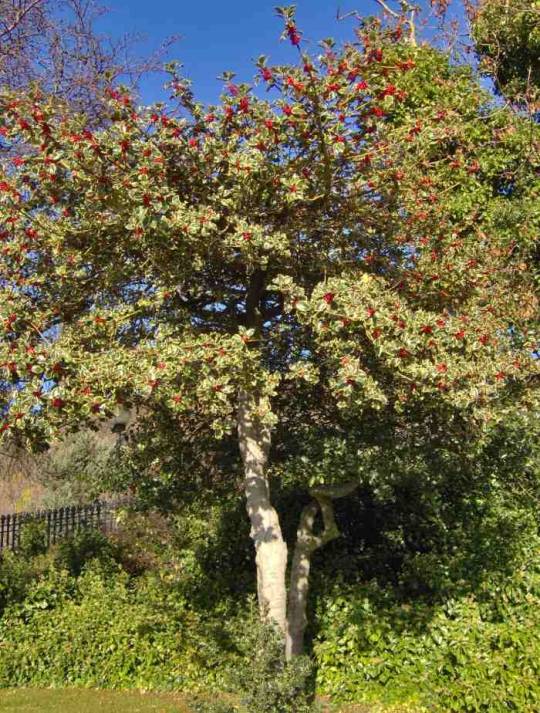
Holly tree.
It will grow in any soil (so long as it isn't too wet), but grows best in rich, sandy or gravelly loam, with good drainage and a moderate amount of moisture at its roots. Its growth is usually stunted in very dry places.
Holly will grow in nearly any soil that isn't saturated with stagnant water. The best place is a thin, scattered oak wood – it will grow up at once in the gaps. Even the worst winters rarely injure it.
Like the beech tree, the trunk of the holly tree often has small wood knots – smooth nodules of solid wood embedded in the bark. They can easily be knocked off/out by a quick blow. The bark is smooth and light grey, often with faint crimson touches. It is often infected with a very thin lichen, which has many curved black lines as its spore-bearing structure (fructification).
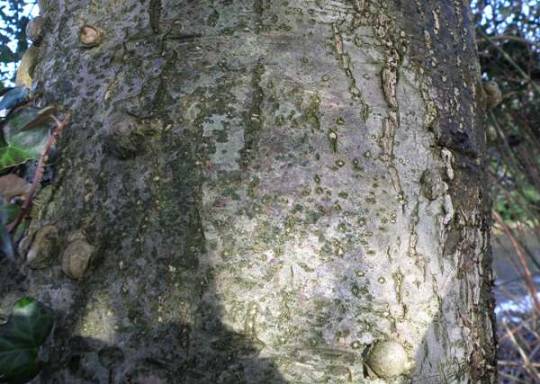
Bark of an old holly tree.
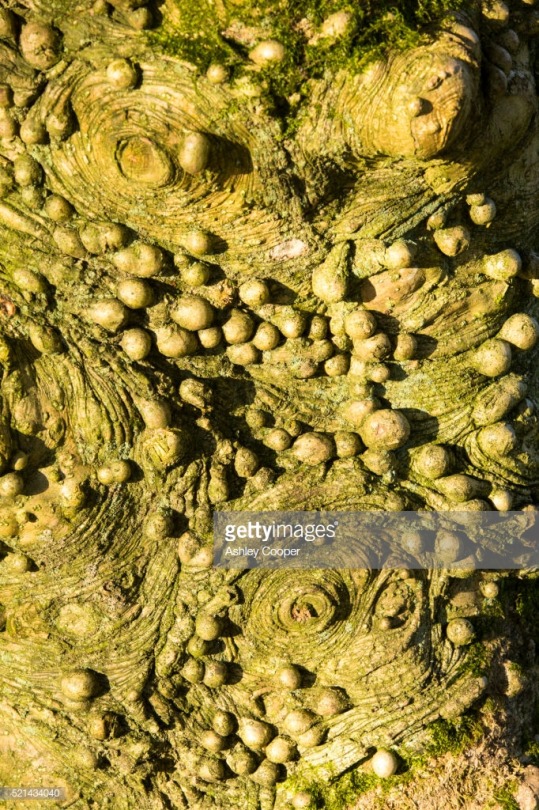
Knobbly growths on a holly tree trunk (Cumbria, England).
The leaf's prickles point alternately upwards and downwards. Only the end prickle is in the same plane as the leaf, and most of the upper leaves only have this one prickle.
The leaves have no taste or smell. They fall off the tree after several years, and because of their leathery texture & durable fibres, they take a long time to decay, withstanding effects of both air and moisture.
Flowers appear in May (late spring), and are succeeded by berries, which mature in October/November (late autumn). One tree will rarely produce an abundance of flowers two years in a row. The male flowers fully develop, but the female flowers don't [?] If the tree is clipped a lot, there aren't likely to be many berries. The berries are usually most abundant in the upper part of the tree.
Birds, rodents and large herbivores (including deer & sheep) eat the berries in late winter, after the frost has made them softer & more edible, and they have fallen to the ground.
Each seed has 3-4 seeds, which germinate in their second or third spring. This delay means by that time, they will usually have been buried in a heap of earth for a year (or more) previously.
Young plants should be transplanted when 30-45cm high, and in autumn. Holly exhausts the soil around it more quickly than most deciduous trees, so if it's going to be a holly hedge, the soil around it should be well-trenched and moderately manured if necessary. The holly plant will take at least 2yrs to recover from being transplanted.
Holly is excellent for a hedge, as it is easily kept trimmed. It forms very thick hedges that are basically impenetrable.
In Morbihan (a department in Brittany, in north-west France), the peasants gather the young holly stems to feed to cattle from November to April (late autumn to mid-spring). The stems are dried and bruised, and fed to the cattle three times a day. They are a very wholesome food; and lead to good milk & butter production.
Apparently, a holly-stick placed in a hutch for the rabbits to gnaw on will act as a tonic, and restore their appetite.
Uses of the Wood
Holly wood is hard, compact, and very even throughout. It is beautifully white (except in the centre of very old trees), and polishes very well. Because of this, it is much prized for ornamental ware, especially for inlaying (such as in Tunbridge ware). Its grain is also very even, making it valuable to the turner [woodturner?].
It has a slightly greenish hue when freshly-cut, but soon becomes perfectly white. Its hardness makes it superior to any other white wood. It retains sap well, causing it to warp, so it must be well-dried and seasoned before being used.

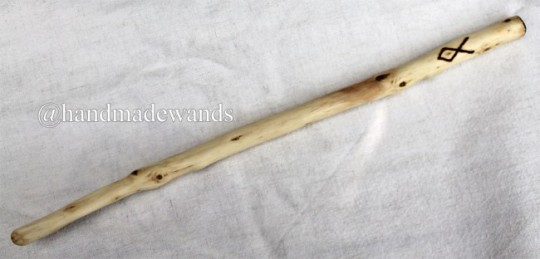
Examples of the wood.
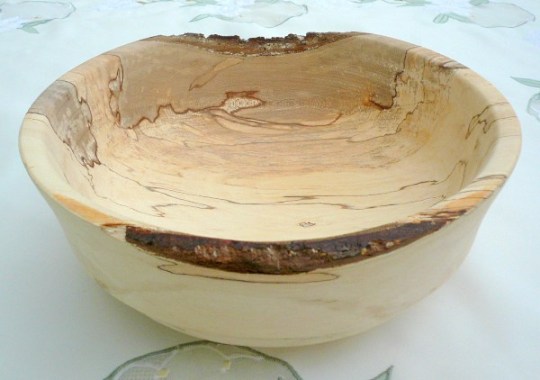
Spalted English Holly (turned).
The best time to cut holly is in the spring, before the sap rises. A sloping cut, as opposed to a straight cut, prevents moisture from remaining on the cut part, which should also be covered in a coating of tar for the same reason. The side growths help draw up the sap, so they should be left.
Holly wood is often stained blue, red, green or black. When stained black, it usually serves as a substitute for ebony (e.g. in the handles of metal teapots). Holly wood is used to make mathematical instruments, and blocks for calico printing. Although it is inferior to boxwood, it has been used as a substitute for it in wood engraving. Wood of the silver-striped variety of holly is said to be whiter than the wood of the common kind.
Straight sticks of this wood are often used for the stocks of light drivings whips, and for walking sticks.
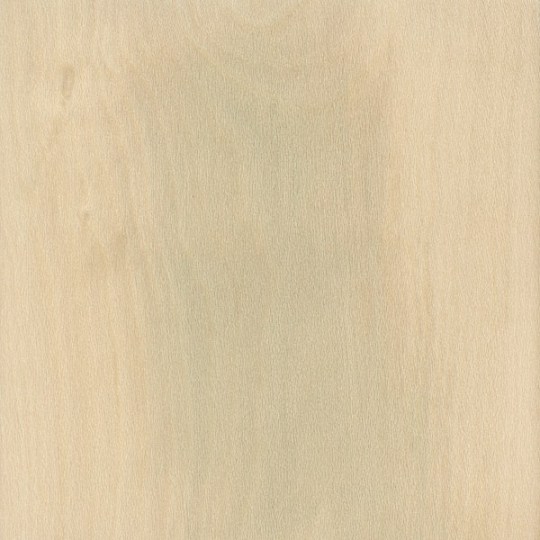
English holly (sanded).
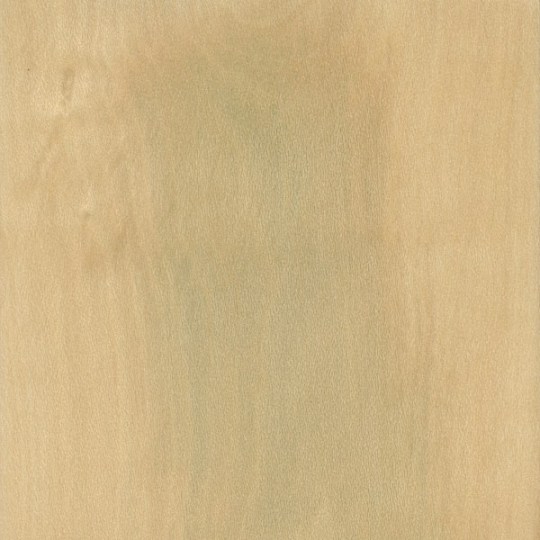
English holly (sealed).
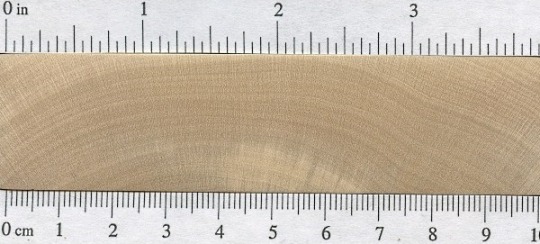
English holly (endgrain - cut across the growth rings).
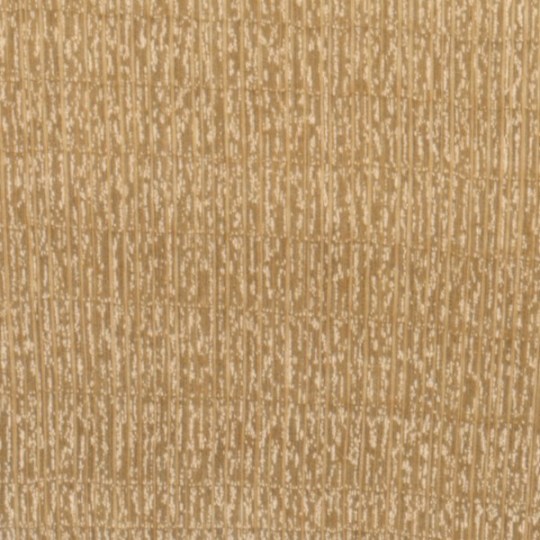
Endgrain (x10).
History
In Ancient Rome, people sent holly boughs, together with gifts, to friends during Saturnalia. The early Christians adopted this custom, but some obviously didn't approve – an edict of the Church of Bracara forbade Christians to decorate their houses with green branches at Christmastime. (Saturnalia was about a week before Christmas.)
In pre-Christian Britain, the Druids decorated their houses with evergreens during winter, so their home could be an abode for forest spirits.
In old church calendars, Christmas Eve is often marked templa exornatur (“churches are decked”). According to legend, holly first sprang up under Jesus' footsteps. In Northern Europe, the plant is referred to as “Christ's Thorn” for this reason. It is also called the “Holy Tree” (including in England).
“Holme” and “Hulver” are also popular names for holly. It used to be called “Holme” in Devon, “Hulver” in Norfolk, and “Holme Chase” in one part of Dartmoor.
Medicine
The leaves, berries and bark have medicinal properties. Leaves that will be dried should be collected in May or June (late spring/early summer), on a dry day, preferably around noon, when there is no longer any trace of dew on them. Stained or insect-eaten leaves shouldn't be used. Fresh leaves are also used.
Holly leaves have been used as a diaphoretic (to induce sweating), and an infusion (prepared by soaking the leaves in liquid) of them have been used to treat catarrh (inflammation of the mucuous membrane leading to excessive mucus in nose/throat), pleurisy and smallpox.
Juice of the fresh leaves has been used for jaundice. The leaves' febrifugal (fever-reducing) & tonic properties have been useful for intermittent fevers and rheumatism.
They have been used successfully when cinchona bark (an Andean flowering tree in western South America) has failed, in the form of a powder, infusion or decoction (prepared by heating/boiling the leaves to extract a concentrated essence). This substitute works because of ilicin, a bitter alkaloid contained in the leaves.
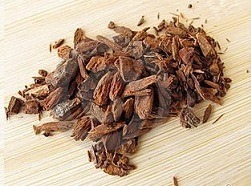
Cinchona bark.
The berries, on the other hand, are violently emetic and purgative (laxative). Even only a few will cause a human to vomit excessively very soon afterwards. However, they have been used to treat dropsy; and powdered berries can treat bleeding as an astringent (causing the contraction of skin cells & other body tissues). They were also used in the past to treat colic.
The English botanist Nicholas Culpeper (c. 1616 – 1654) stated that “the bark and leaves are good used as fomentations for broken bones and other members as are out of joint.” A fomentation is a poultice.
Holly bark can also be used to make birdlime. The bark is stripped off around midsummer, steeped in clean water, and boiled until it separates into layers. The inner green layer is piled up into small heaps, and left until it ferments, which takes about a fortnight.
The sticky substance is then pounded into a paste, washed, and put aside to ferment again. Finally, it is mixed with some oily substance (preferably goose-fat).
In northern England, holly was once so abundant in the Lake District that large quantities of it were used to make birdlime, which was shipped to the East Indies for destroying insects.
In the Black Forest (in south-west Germany), holly leaves have been used for tea leaves. In Brazil, “Paraguay Tea” is a popular drink, made from the dried leaves & shoots of Ilex paraguariensis, a South American species of holly also known as yerba mate.
Ilex gongonha and Ilex theezans are also used for tea in Brazil. All three of these species are valuable as diaphoretics and diuretics (increase urination).
The leaves of Ilex paraguariensis (and several other species) are used in dyes. The unripe fruits of Ilex Macoucoua have high levels of tannin, so when bruised in a ferruginous mud, they can be used in dyeing cotton, acting somewhat like galls (a type of abnormal swelling growth on the outside of plants, fungi and animals).
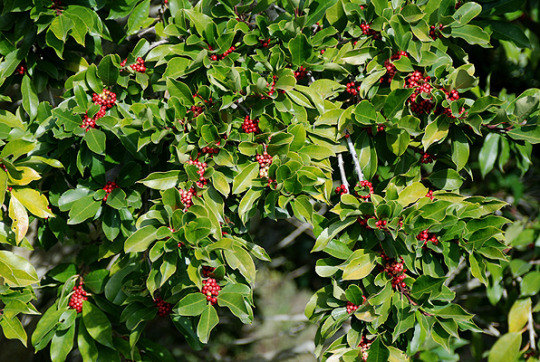
Ilex paraguariensis.
Pliny
Pliny the Elder (d. 79 AD) wrote about holly in his Naturalis Historia, calling it Aquifolius (“needle leaf”). He states that it was the same tree that Theophrastus (c. 371 – c. 278 BC) called Crataegus, but later commentators deny this. According to Pliny:
Crushed holly leaves, mixed with salt, are good for diseases of the joints.
Holly berries – for menstruation, coeliac problems, dysentery and cholera. A wine made from them can help with diarrhoea.
A decoction of holly root can extract objects embedded in the flesh, and can also be used for dislocations and swellings.
A holly tree planted in a town/country house will ward off magic influences and protect the house from lightning.
Holly flowers cause water to freeze (he attributes this to Pythagoras).
If you throw the wood at an animal and miss, it will roll closer towards is (also attributed to Pythagoras). It will also compel the animal to return and lie down by you.
[Source]
#history#classics#botany#folklore#ancient rome#brazil#paraguay#holly#yerba mate#pliny the elder#pythagoras
5 notes
·
View notes
